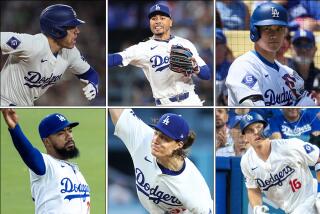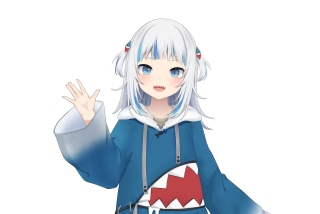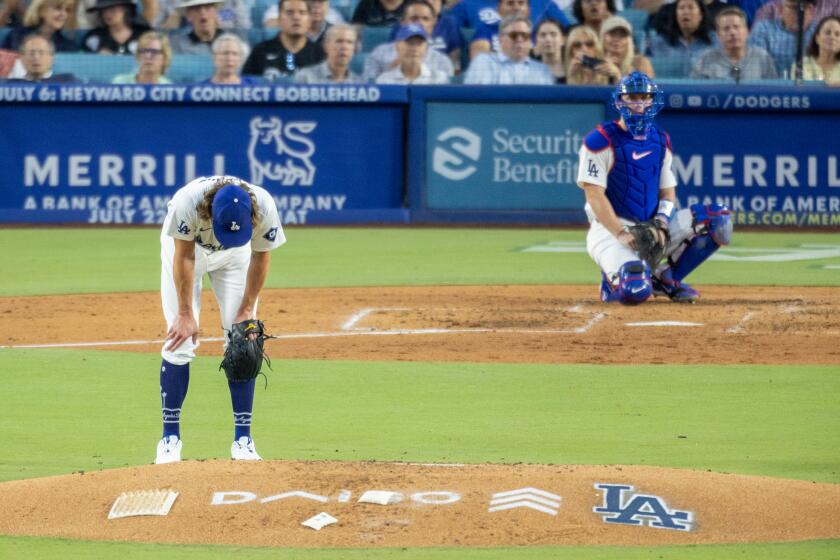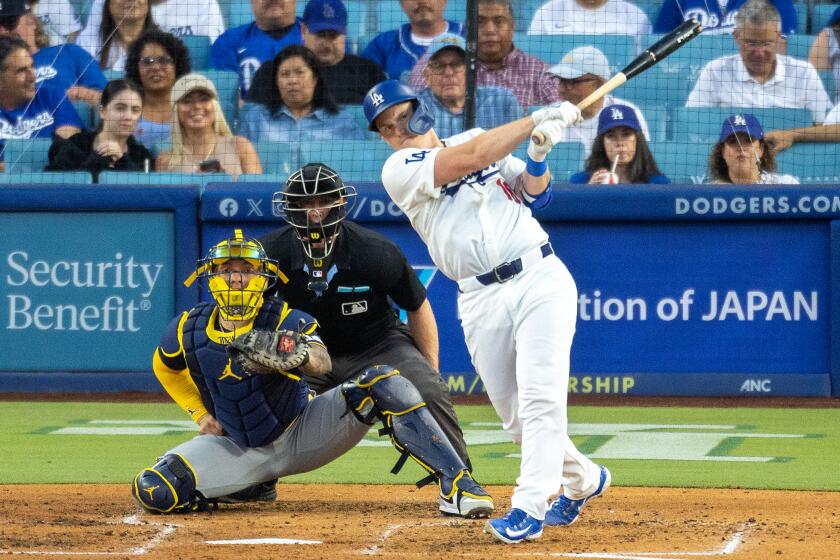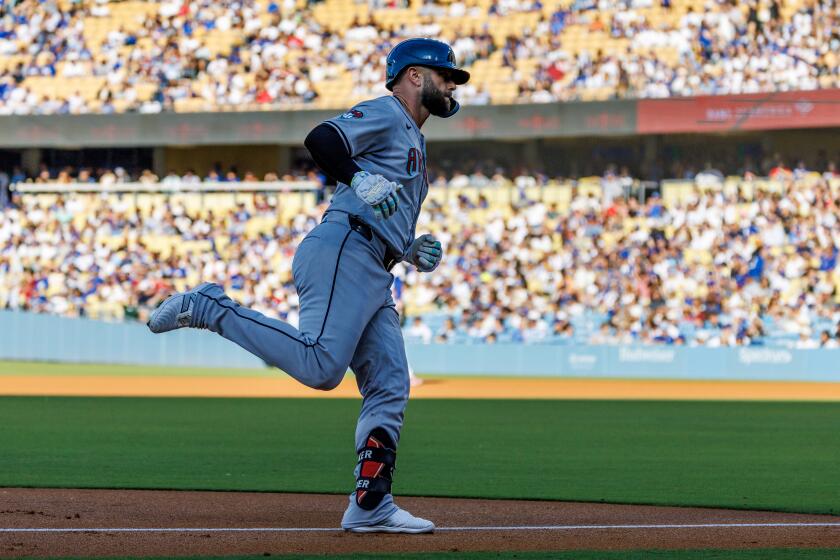Third Base Isn’t Dodgers’ Charm : Baseball: Since Cey was traded before ’83 season, 23 players have been tried there.
Since the Dodgers ended 10 years of relative stability at third base by trading Ron Cey to the Chicago Cubs before the 1983 season, 23 players have tried their hand there.
Remember Rafael Landestoy and German Rivera? Tracy Woodson and Phil Garner? Eddie Murray logging two games there in 1989?
Is the hot corner too hot for the Dodgers to handle?
For the ninth season since Cey’s departure, Manager Tom Lasorda will try to find the right combination while making several critical decisions:
--Can Jeff Hamilton come back from a serious shoulder injury without surgery?
--Can Stan Javier, the team’s best outfielder last year, play third base?
--What happens to last year’s platoon of Mike Sharperson and Lenny Harris, who provided solid play but little power?
Lasorda already has clouded the picture by saying the job is Hamilton’s if his shoulder is healed, while making a personal appeal to Javier to leave the outfield, where he is odd man out after the signings of Darryl Strawberry and Brett Butler.
And, of course, Harris and Sharperson are still on the team, competing for time at second and third, with a possible push from rookie Dave Hansen.
“Really, there’s no explanation” for the revolving door at third, Cey said this week. “It seems like the Dodgers are bending over backward to get this monkey off their back, and the harder they try, the worse it gets.”
But it’s not as if this is anything new.
From the time the Dodgers moved to Los Angeles in 1958 until Cey arrived in 1972, 43 players were tried at third, from the likes of Dick Gray and Charlie Neal and Bart Shirley to an end-of-the-line Ken Boyer to a scatter-armed Steve Garvey and an enigmatic Dick Allen, who would deliver a most-valuable-player season as soon as the Dodgers traded him to the Chicago White Sox--where he resumed being a full-time first baseman in ’72.
During that period the only third basemen who put down any roots were Jim Gilliam, who switched from second to third in the early 1960s; and Jim Lefebvre, who helped anchor the Dodgers’ all-switch-hit infield in the late 1960s.
After playing a handful of games in 1972, Cey took up residence at third the next season, staying there for 10 years and playing more games than all but a few players in the Dodgers’ century-long history, accounting for 224 home runs, 842 runs batted in and six All-Star Game appearances.
It tells you something about the mercurial history of L.A. Dodger third basemen that only Gilliam played even half as many games as Cey at third, and Hamilton--who has put in one full season there--ranks fourth in games played at that position.
Cey, who had the advantage of having played for Lasorda in the minors, joined shortstop Bill Russell, second baseman Dave Lopes and Garvey at first in the longest-running continuous infield in baseball history.
But the game has changed since Cey’s day.
“I never looked at it like (I was) stabilizing a position,” he said. “If I got a chance, I was going to make the best of it. We had (the same) eight guys go out every day.
“The Dodgers used to nurture young talent. They brought us along through the minors, and we formed the nucleus of the club. It’s a different game now. Baseball is leaning more toward platooning and feeding stats into a computer. Guys have to be able to play more positions and move around.”
In the 1950s and ‘60s and even into Cey’s era, third base was a position teeming with clean-up-type run producers with gold gloves--such perennial all-stars as Eddie Mathews, Mike Schmidt, Ron Santo, Tony Perez and Boyer. That’s no longer the case.
“I couldn’t begin to tell you . . . why someone has not handled the position (for the Dodgers) with regularity,” said Cey, who keeps an eye on his old team as a cable TV analyst. “But it’s throughout baseball. Today there are not a lot of names that come to the fore.
“To me, the prototype third baseman is (San Francisco’s) Matt Williams, who hits for power, has great hands and a strong arm. Tim Wallach of the Montreal Expos has been solid. Those two are probably the best combination offense-defense guys in the National League. Chris Sabo is also a fine player at Cincinnati.”
None of which solves the Dodgers’ problem of finding the right third baseman. Since Cey was traded, the Dodgers have had proven hitters, Pedro Guerrero and Bill Madlock, but haven’t come up with a slick fielder who could hit with power and drive in runs.
In 1983, Guerrero played 157 games at third, hit .298 with 32 home runs and drove in 103 runs, helping the Dodgers win the Western Division title. He also committed 31 errors. By 1985 he was playing most of his games in the outfield and later switched to first.
For pennant insurance that year the Dodgers got Madlock, who hit .360 in September and helped clinch another division title. The next year, as the full-time third baseman, Madlock hit .280 with 60 RBIs and 26 errors. He was traded to the Detroit Tigers after 21 games of the 1987 season.
For comparison, gold glove winner Terry Pendleton, then of the St. Louis Cardinals, played most of his games on artificial turf but committed only 15 errors while playing all 162 games in 1989.
The only Dodger to lay claim to third since has been Hamilton, who started 147 games there in 1989, hitting 12 homers and driving in 56 runs while taking part in more double plays, 29, than errors, 19.
But Hamilton’s reign ended seven games into the 1990 season, when he suffered a torn rotator cuff in his throwing shoulder. Choosing to avoid surgery, Hamilton spent the summer with his shoulder hooked up to a portable electrical stimulus machine. His status at Dodger training camp is still uncertain.
In a platoon setup last year, Sharperson hit .297 with 36 RBIs and 15 errors. Since Cey departed, Dodger management hasn’t shown a lot of patience in developing its young players, with the exception of the pitching staff.
Cey points out that today’s game, with veteran players moving about freely, doesn’t give teams who expect to contend time to prepare many youngsters.
“You’ve got to either rush the kids up to the majors, sign a free agent or trade,” Cey said. “You’ve got to play the game the others play. If (opposing) clubs strengthen themselves through free agency, you’ve got to do something or get lost in the shuffle.”
Conversely, the market rate might mean you don’t take a chance on an attractive free agent such as Pendleton, whose good glove and occasional power got him a multimillion-dollar contract with the Atlanta Braves, even though he hit .231 last year.
“Would I sign Pendleton? Not for the money he’s making, when you look at his (offensive) stats,” Cey said.
So Lasorda will probably continue to shuffle the deck at third and look for the next Schmidt. Or the next Cey.
THERE WAS CEY, AND 66 OTHERS Statistics of Ron Cey, and the 23 Dodgers who followed him at third base after the 1982 season. Forty-three Dodgers preceded Cey after the team moved to Los Angeles in 1958.
PLAYER YRS G/3B AB HR RBI BA E Ron Cey 1972-82 1,481 5,216 228 842 .264 166 Derrell Thomas 1979-83 522 1,211 12 100 .257 42 Mickey Hatcher 1979-80 458 1,011 12 115 .272 29 1987-90 Pedro Guerrero 1979-85 794 2,781 134 451 .306 93 Alex Taveras 1982-83 21 7 0 2 .143 0 Dave Anderson 1983-89 662 1,616 13 116 .232 57 Rafael Landestoy 1983-84 188 123 2 3 .171 9 German Rivera 1983-84 107 244 2 17 .266 16 Bob Bailor 1984-85 139 249 0 15 .261 9 Candy Maldonado 1984 116 254 5 28 .268 8 Bill Russell 1985-86 181 385 0 31 .255 15 Enos Cabell 1985-86 164 612 4 65 .265 20 Bill Madlock 1985-87 166 379 10 60 .280 26 Craig Shipley 1986-87 38 62 0 6 .194 6 Jeff Hamilton 1986-90 375 1,111 23 110 .235 43 Tracy Woodson 1987-98 122 315 4 22 .235 10 Phil Garner 1987 70 238 5 23 .190 13 Mike Sharperson 1987-90 212 477 3 46 .289 15 Lenny Harris 1989-90 191 578 3 44 .291 11
OTHERS PLAYING THIRD BASE AFTER CEY
Steve Sax, two games (1985, 1987); Len Matuszek, one game (1985); Alex Trevino, one game (1987); Eddie Murray, two games (1989), Dave Hansen (1990), five games.
PLAYERS PRECEDING CEY AFTER TEAM MOVED TO LOS ANGELES
Dick Gray (1958-59), Earl Robinson (1958), Randy Jackson (1958), Jim Gilliam (1958-66), Pee Wee Reese (1958), Charlie Neal (1958), Gil Hodges (1958-60), Don Zimmer (1958-60, 1963), Jim Baxes (1959), Bob Lillis (1960-61), Tommy Davis (1960-61, 1963, 1966), Charlie Smith (1960), Bob Aspromonte (1960-61), John Roseboro (1960, 1965), Daryl Spencer (1961-63), Lee Walls (1962-63), Andy Carey (1962), Maury Wills (1963-64, 1966, 1970-72), Ken McMullen (1963-64, 1973-75), Marv Breeding (1963), Bill Skowron (1963), John Werhas (1964), Dick Tracewski (1964-65), Bart Shirley (1964), Derrell Griffith (1964), John Kennedy (1965-66), Don LeJohn (1965), Jim Lefebvre (1966-72), Dick Schofield (1966-67), Nate Oliver (1966), Bob Bailey (1967-68), Jim Hickman (1967), Ron Hunt (1967), Luis Alcaraz (1968), Ken Boyer (1968), Paul Popovich (1968), Bill Sudakis (1968-71), Bill Grabarkewitz (1969-72), John Miller (1969), Steve Garvey (1970-72), Manny Mota (1970), Bobby Valentine (1971-72) and Richie Allen (1971).
More to Read
Are you a true-blue fan?
Get our Dodgers Dugout newsletter for insights, news and much more.
You may occasionally receive promotional content from the Los Angeles Times.
